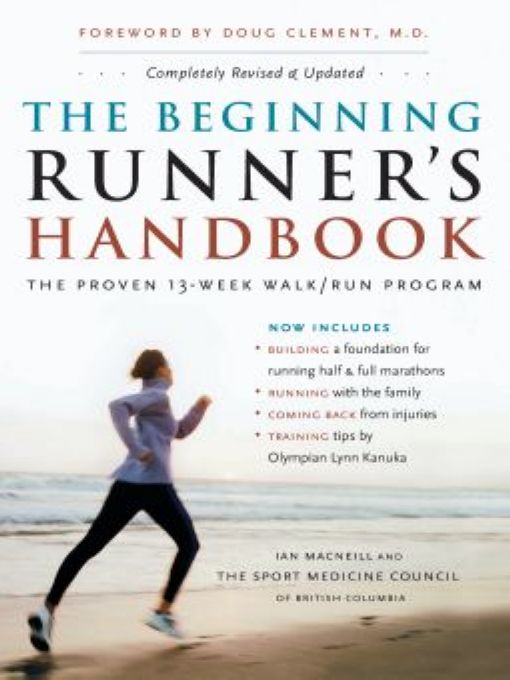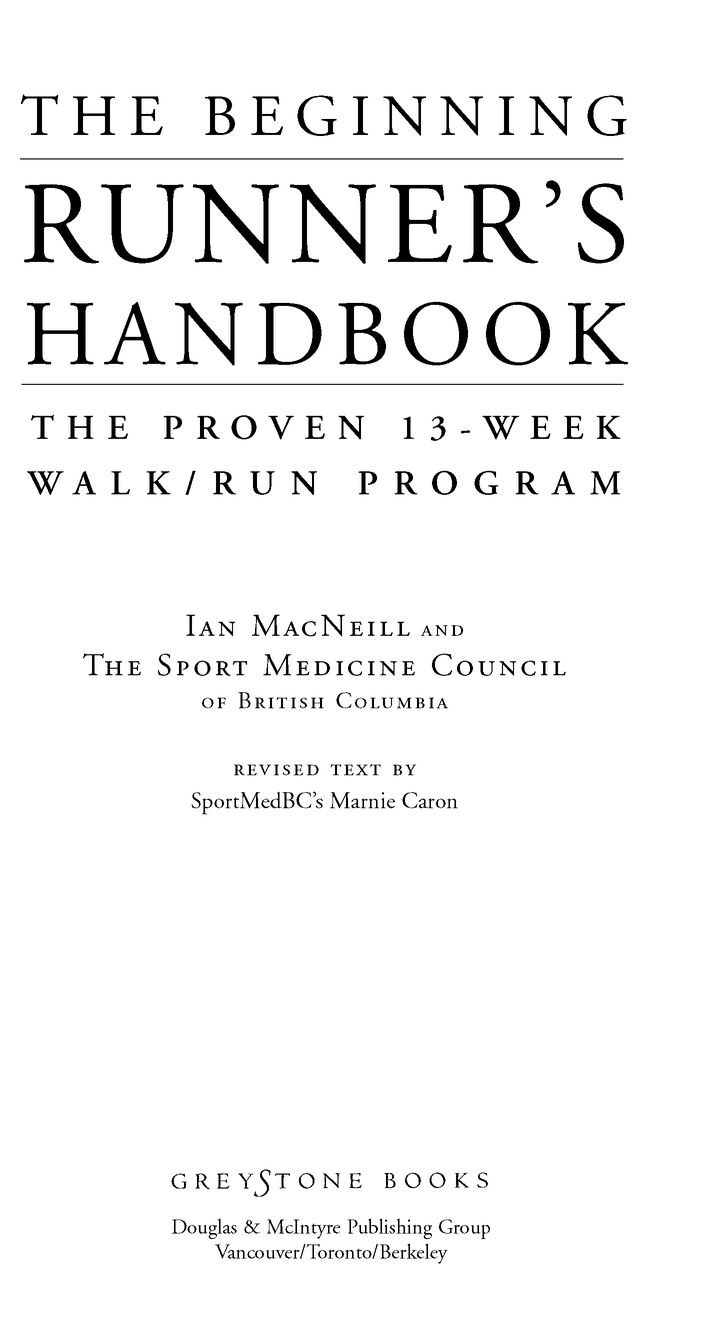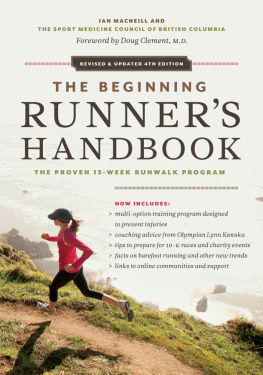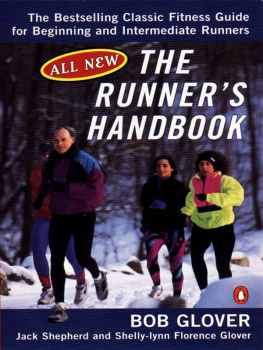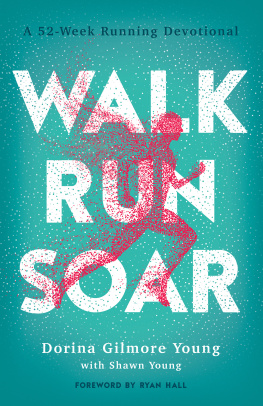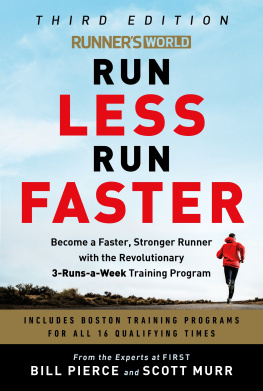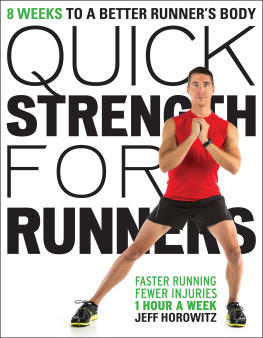Table of Contents
I would like to acknowledge and give thanks
to all of the people who have provided direction, support
and inspiration, with special thanks to
Lynda Cannell, Patricia Chuey, Dr. Doug Clement, Wendy Epp,
Jeanne Gordon, Jackie Halloway, Lynn Kanuka,
Thom Lutes, Jim Miller, Phil Moore,
Denise Morbey, Dr. Karen Nordahl, Cindy OKrane,
Dallas Parsons, Dr. Trent Smith,
Dr. Jack Taunton, Jerry Tighe and Rachel Turner-Bourne.
MARNIE CARON
Foreword
IT IS IMPOSSIBLE TO DRIVE DOWN ANY ROAD OR WALK IN A park without being reminded that many people choose running as a way to maintain or improve their health. Running has gained popularity not only because it requires scant equipment and is portable to any site, but because it has been proven to reduce the risk of such conditions as heart disease, high blood pressure, diabetes, obesity and depression. And to get these benefits requires an outlay of just a few hours each week. Small wonder that hundreds of thousands of enthusiasts around the world find running an ideal form of exercise and a good path to physical fitness.
This book is aimed at the would-be runner who needs information about how to become fit. Running appears to be so simple that many individuals approach it thinking success will come easily; beginning runners often get hurt because they train too intensely and too frequently. The moderate, 13-week walk/run program and the guidance offered in this book equip an aspiring runner with the knowledge essential to achieving his or her goal in manageable stages, with minimal risk of injury.
As a former Olympic runner, and coach to dozens of Olympic runners over the past 55 years, I believe in the intrinsic value of running. But as a sport medicine specialist, I know that most of the more than half-million patients entering the clinic with which I am associated have been runners. Had they followed a program like the one presented here, it is far less likely that they would have had to seek medical treatment. This book offers the most concise presentation of information for the beginning runner I have ever seen. I recommend it to every reader as the path to a healthy fitness routine and a more enjoyable life.
Doug Clement, M.D.
Introduction
THIS BOOK WAS WRITTEN SPECIFICALLY FOR BEGINNING runners. It has been designed to answer the practical questions you may have about getting started. It will tell you how to avoid sore muscles and injury. It will give you advice about motivation and help you set realistic and achievable goals. And, most important, it will provide you with a recipe for success, a tried and true training program for starting to run.
The heart and soul of this book is the Sport Medicine Council of British Columbias (SportMedBC) InTraining program, the 13-week walk/run program that has its roots in what is now one of the worlds most popular 10-k runs, the Vancouver Sun Run. A relatively obscure event when it started in 1983, the Sun Run now attracts thousands of runnersnearly 50,000 participated in 2004. But as the run started to grow, event organizers noticed that the frequency of running-related injuries had risen. A good number of the runners were first-timers and many of them hadnt properly trained or prepared for the event. It wasnt until after they were injured that they learned the necessary steps required to safely go the distance. Either that, or they quit altogether.
It seemed clear that many participants would benefit from receiving expert advice before the run.
The program presented in this book was originally developed by Dr. Doug Clement, a sport medicine physician, former Canadian national team running coach and recently retired co-director of the Allan McGavin Sport Medicine Centre at the University of British Columbia. After several years of treating a steady stream of running casualties, he decided to design a training plan that neophyte runners could follow and benefit from. The mandate was simple: develop a graduated program that intersperses walking with jogging or running in order to help people develop the physical robustness to run, walk or jog a 10-k course without getting injured.
In 1996, the 13-week program became the basis for a series of community-based running clinics created and administered by SportMedBC. They were made available at local recreation centers, fitness clubs and YMCAs/ YWCAs. Although the fundamentals of the program stayed the same (walking interspersed with jogging or running), each training segment was carefully fine-tuned. Over five years, the original training program was then modified to fit the real-life experiences of the more than 35,000 individuals who used the program. Compelled by the testimonials of clinic participantssome of whom claimed that following the program provided one of the most rewarding, life-altering experiences they had ever hadwe decided to take the program to a larger audience. Since then, tens of thousands of people worldwide have accomplished their running goals using the Beginning Runners Handbook.
This program has been proven to work by people who may have been fearful at first, but who doggedly set goals and persevered to achieve them. The book includes first-hand accounts from many of these runnerstelling about their challenges, setbacks, successes and failures. As well, it includes guidance from a wide range of professionals, all experts in their respective fields of nutrition, sport medicine, sport science, psychology and coaching.
Whether you want to start running to lose weight, relieve stress, quit smoking, reduce your cholesterol levels, meet new people or simply get fitter, this book will help you meet your goal. You will learn how to start an exercise regime the right way, and you will be able to learn from the mistakes and successes of others. Best of all, once you have started the program, you will be able to come back to the book and review specific sections for encouragement, advice and reinforcement. Having the book is a bit like having a personal running coach in your back pocket. If you use a logbook, and we highly recommend that you do, this book will also help serve as a permanent record of your achievement. (See page 192 for a sample logbook page. The Beginning Runners Journal, the companion text to this book, provides a complete logbook. See page 207 for source info.)
A word of caution. As you thumb through the book and flip to the training program itself, you may at first glance think the 13-week walk/run program looks too easy. You may wonder what walking has to do with training to become a runner. The answer is that your bones, ligaments, tendons and muscles require a very slow and gradual buildup to activity, particularly if they havent seen much action for a while; walking helps prepare them for the stress of running. Although you may be tempted to go out and just start running on your own, or to jump ahead, you should stick to the program. There is no magic potion you can swallow to become a runner, no short cuts to or untold secrets of success. The 13-week program requires dedication and a certain amount of perseverance.
We do know, however, that it works. Even if you have no intention of toeing up to the start line of a race, consider making a commitment to follow the program. At the end of the 13 weeks, not only will you will feel better but youll be healthier as well. Who knows? You might even become a runner for life.

